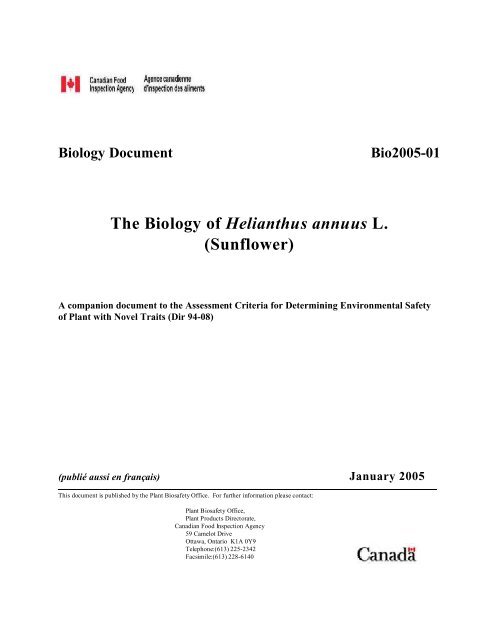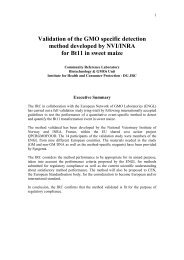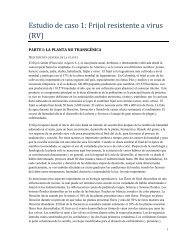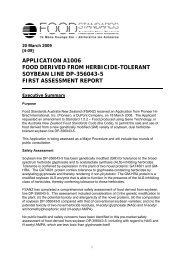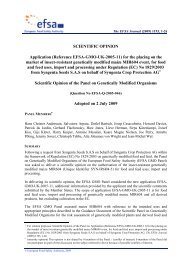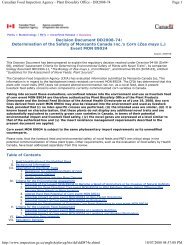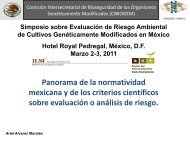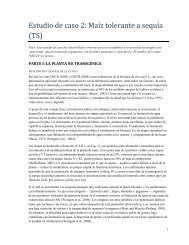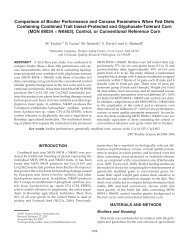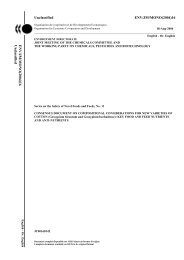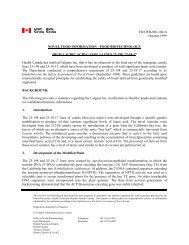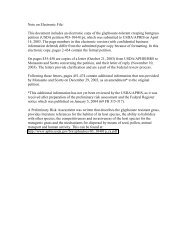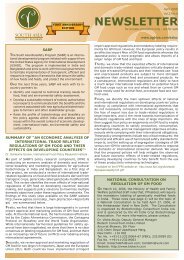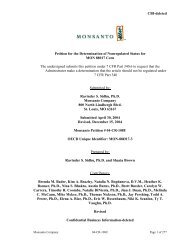The Biology of Helianthus annuus L. (Sunflower) - CERA
The Biology of Helianthus annuus L. (Sunflower) - CERA
The Biology of Helianthus annuus L. (Sunflower) - CERA
You also want an ePaper? Increase the reach of your titles
YUMPU automatically turns print PDFs into web optimized ePapers that Google loves.
<strong>Biology</strong> Document<br />
Bio2005-01<br />
<strong>The</strong> <strong>Biology</strong> <strong>of</strong> <strong>Helianthus</strong> <strong>annuus</strong> L.<br />
(<strong>Sunflower</strong>)<br />
A companion document to the Assessment Criteria for Determining Environmental Safety<br />
<strong>of</strong> Plant with Novel Traits (Dir 94-08)<br />
(publié aussi en français) January 2005<br />
This document is published by the Plant Biosafety Office. For further information please contact:<br />
Plant Biosafety Office,<br />
Plant Products Directorate,<br />
Canadian Food Inspection Agency<br />
59 Camelot Drive<br />
Ottawa, Ontario K1A 0Y9<br />
Telephone:(613) 225-2342<br />
Facsimile:(613) 228-6140
Table <strong>of</strong> Contents<br />
A. General Information ..................................................1<br />
A1.0 Background ..........................................................1<br />
A2.0 Scope ...............................................................1<br />
B. <strong>The</strong> <strong>Biology</strong> <strong>of</strong> <strong>Helianthus</strong> <strong>annuus</strong> L. ....................................2<br />
B1.0 General Description, Cultivation and Use as a Crop Plant ......................2<br />
B2.0 <strong>The</strong> Centres <strong>of</strong> Origin <strong>of</strong> the Species ......................................3<br />
B3.0 <strong>The</strong> Reproductive <strong>Biology</strong> <strong>of</strong> H. <strong>annuus</strong> ....................................3<br />
B4.0 Breeding, Seed Production and Agronomic Practices for <strong>Sunflower</strong> ..............4<br />
B5.0 Cultivated H. <strong>annuus</strong> as a Volunteer Weed ..................................5<br />
C. Related species <strong>of</strong> <strong>Helianthus</strong> <strong>annuus</strong> L. ..................................6<br />
C1.0 Inter-species/Genus Hybridization ........................................6<br />
C2.0 Potential for Introgression <strong>of</strong> Genetic Information from Cultivated H. <strong>annuus</strong> into<br />
Relatives ............................................................7<br />
C3.0 Summary <strong>of</strong> Ecology <strong>of</strong> Relatives <strong>of</strong> H. <strong>annuus</strong> ..............................8<br />
D. Potential Interactions <strong>of</strong> <strong>Helianthus</strong> <strong>annuus</strong> L. with Other Life Forms<br />
During its Life Cycle ..................................................8<br />
Table 1. Examples <strong>of</strong> Potential Interactions <strong>of</strong> <strong>Helianthus</strong> <strong>annuus</strong> L. with Other Life<br />
Forms During its Life Cycle ......................................9<br />
E. Acknowledgements ..................................................11<br />
F. Bibliography ........................................................11
A. General Information<br />
A1.0 Background<br />
<strong>The</strong> Canadian Food Inspection Agency's (CFIA) Plant Biosafety Office (PBO) is responsible for<br />
regulating the intentional introduction <strong>of</strong> plants with novel traits (PNTs) into the Canadian<br />
environment.<br />
PNTs are plants containing traits not present in plants <strong>of</strong> the same species already existing as<br />
stable, cultivated populations in Canada, or are expressed outside the normal statistical range <strong>of</strong><br />
similar existing traits in the plant species.<br />
PNTs that are subject to an environmental safety assessment are those plants that are potentially<br />
not substantially equivalent, in terms <strong>of</strong> their specific use and safety for the environment and for<br />
human and animal health, to plants currently cultivated in Canada, with regard to<br />
weediness/invasiveness, gene flow, plant pest properties, impacts on other organisms and impact<br />
on biodiversity.<br />
Consistent with the Canadian approach, the CFIA recognizes that it is the presence <strong>of</strong> a novel trait<br />
in a plant that potentially poses environmental risk, and hence is subject to regulatory oversight, as<br />
opposed to how the traits are specifically introduced, e.g., introduction <strong>of</strong> novel traits by<br />
traditional breeding, mutagenesis, recombinant DNA techniques, etc.<br />
Before PNTs may be authorized for unconfined environmental release, they must be assessed for<br />
environmental safety. Regulatory Directive Dir94-08: Assessment Criteria for Determining<br />
Environmental Safety <strong>of</strong> Plants with Novel Traits describes the criteria and information<br />
requirements that must be considered in the environmental assessment <strong>of</strong> PNTs to ensure<br />
environmental safety in the absence <strong>of</strong> confined conditions.<br />
<strong>The</strong> assessment criteria are designed to be used in conjunction with species-specific biology<br />
documents that describe the biology <strong>of</strong> the species to which the modified plant belongs, including<br />
details <strong>of</strong> other life forms with which it interacts. <strong>The</strong> assessment is part <strong>of</strong> the continuum <strong>of</strong><br />
research, development, evaluation and potential commercialization <strong>of</strong> plants with novel traits.<br />
A2.0 Scope<br />
<strong>The</strong> present document is a companion document to Dir94-08: Assessment Criteria for<br />
Determining Environmental Safety <strong>of</strong> Plants with Novel Traits. It is intended to provide<br />
background information on the biology <strong>of</strong> <strong>Helianthus</strong> <strong>annuus</strong> L., its centre <strong>of</strong> origin, its related<br />
species, the potential for gene introgression from H. <strong>annuus</strong> into relatives, and details <strong>of</strong> the life<br />
forms with which it may interact.<br />
Such species-specific information will serve as a guide for addressing some <strong>of</strong> the information<br />
requirements <strong>of</strong> Appendix 4 <strong>of</strong> Dir94-08. Specifically, it will be used to determine if there are<br />
1
significantly different/altered interactions with other life forms resulting from the PNTs novel<br />
gene products which could potentially cause the PNT to become a weed <strong>of</strong> agriculture, become<br />
invasive <strong>of</strong> natural habitats, or be otherwise harmful to the environment.<br />
<strong>The</strong> conclusions drawn in this document about the biology <strong>of</strong> H. <strong>annuus</strong> only relate to plants <strong>of</strong><br />
this species with no novel traits.<br />
B. <strong>The</strong> <strong>Biology</strong> <strong>of</strong> <strong>Helianthus</strong> <strong>annuus</strong> L.<br />
B1.0 General Description, Cultivation and Use as a Crop Plant<br />
<strong>Helianthus</strong> is a genus in the tribe Heliantheae <strong>of</strong> the Compositae family. <strong>The</strong> genus consists <strong>of</strong><br />
annual and perennial species. <strong>The</strong> cultivated species H. <strong>annuus</strong> known also as sunflower has<br />
close wild species relatives.<br />
<strong>The</strong> cultivated H. <strong>annuus</strong> as described by Heiser, 1978 and Seiler, 1997 for the most part are tall,<br />
but varieties have been developed that range from 50 to 500 cm. <strong>The</strong> stems are typically<br />
unbranched and along with most other parts <strong>of</strong> the plant vary from glabrous to very densely<br />
pubescent. Stem length is determined by the number <strong>of</strong> internodes. <strong>The</strong> first leaves are always<br />
opposite but in some varieties become alternate. <strong>The</strong> leaves are usually petiolate and three<br />
nerved, vary in shape from linear to ovate and are usually entire or serrated. <strong>The</strong> color intensity<br />
could vary from light to dark green. <strong>The</strong> heads are radiate and the ray flowers are neutral or<br />
pistillate. <strong>The</strong>y are usually large and yellow but the color can range from lemon-yellow, orange to<br />
reddish.<br />
<strong>The</strong> inflorescence is a capitulum or head, characteristic <strong>of</strong> the Compositae family. It consists <strong>of</strong><br />
300 to 1000 flowers but could be higher in non-oil cultivars. <strong>The</strong> outer whorl <strong>of</strong> disk flowers<br />
open first, at about the time that ray flowers spread out from their folded position against the buds<br />
<strong>of</strong> disk flowers. Successive whorls <strong>of</strong> one to four rows <strong>of</strong> disk flowers open daily for 5 or more<br />
days.<br />
<strong>The</strong> attitude <strong>of</strong> the head is variable. <strong>The</strong> head shape varies, being concave, convex or flat.<br />
<strong>The</strong> achene, or fruit <strong>of</strong> the sunflower consists <strong>of</strong> a seed, <strong>of</strong>ten called the kernel, and adhering<br />
pericarp, usually called the hull. In the absence <strong>of</strong> fertilization, the achenes will be empty, with no<br />
kernel. Achenes vary from 7 to 25 mm in length and 4 to 13 mm in width. <strong>The</strong>y may be linear,<br />
oval or almost round.<br />
Early cultivation <strong>of</strong> sunflower in North America was mainly for silage and to some extent as<br />
scratch feed for poultry (Dedio et al., 1980). It was not until the crop was re-introduced from<br />
Russia that it received attention as a possible oilseed crop (Putt, 1978). Because <strong>of</strong> its long<br />
2
season, its centre <strong>of</strong> production in Canada is in southern Manitoba, extending to northern States,<br />
with small amounts grown in Saskatchewan and Alberta. Its fair drought resistance and<br />
susceptibility to disease- particularly sclerotinia- makes it suitable for production in drier areas <strong>of</strong><br />
the country.<br />
<strong>The</strong> sunflower is cultivated primarily for its seeds, which yield one <strong>of</strong> the worlds most important<br />
sources <strong>of</strong> edible oil. <strong>Sunflower</strong> oil is considered a premium oil because <strong>of</strong> its light colour, high<br />
level <strong>of</strong> unsaturated fatty acids, lack <strong>of</strong> linolenic acid, lack <strong>of</strong> trans fat, bland flavour, high<br />
oxidative stability and high smoke points. <strong>The</strong> oil is used for cooking, margarine, salad dressings,<br />
baby formula, lubrication, bio-fuel, hydrolic fluids, soaps, illumination and certain types <strong>of</strong> paints,<br />
varnishes and plastics. <strong>The</strong> meal left after the oil has been extracted is a valuable animal feed<br />
with 50-60% protein.<br />
Lately, traditional sunflower acreage in Canada has shifted somewhat to non-oil sunflower<br />
varieties. <strong>The</strong>ir large achenes are lower in oil and higher in protein than those <strong>of</strong> the smaller<br />
oilseed type. <strong>The</strong>se seeds are used for human consumption either raw, roasted, salted, made into<br />
flour or as dehulled kernels in bread baking. <strong>The</strong>y are also used as birdfeed and as a high protein<br />
meal for livestock. <strong>The</strong> flowers are used as a yellow dye, and the plant itself can be used for<br />
fodder, silage and as a green-manure crop.<br />
Some sunflowers are grown as ornamentals, and varieties have been developed with exotic colors.<br />
B2.0 <strong>The</strong> Centres <strong>of</strong> Origin <strong>of</strong> the Species<br />
<strong>Helianthus</strong> <strong>annuus</strong> L. is a native <strong>of</strong> North America. Its wild relatives and other <strong>Helianthus</strong><br />
species are distributed widely across the Central Plains <strong>of</strong> Canada from north to south. Heiser,<br />
1954 reports 67 species, but there is much doubt whether all are distinct species as hybridization<br />
has been found to occur. Archeological evidence seems to indicate the crop was domesticated in<br />
the central part <strong>of</strong> USA. <strong>The</strong>re are both annual and perennial species, with polyploidy occurring<br />
in the latter group.<br />
B3.0 <strong>The</strong> Reproductive <strong>Biology</strong> <strong>of</strong> H. <strong>annuus</strong><br />
<strong>The</strong> sunflower is an annual crop that is propagated by seed only and can hybridize spontaneously<br />
with several wild/weedy relatives (Burke et al., 2002). Until the 1960's the cultivars grown were<br />
open-pollinated and cross-pollinated mostly by insects. <strong>The</strong>y, along with the wild species, were<br />
highly self-incompatible. Current commercial sunflower varieties are self-compatible, however<br />
environmental conditions can influence the level <strong>of</strong> self-fertility expressed (Snow et al., 1998).<br />
Pollen transfer is via insect pollinators, principally bees. <strong>The</strong> pollen is spiney and adapted to be<br />
transported by insects. Little is pollinated by wind, as the pollen is rather heavy (Fick, 1978). It<br />
may be viable for several days. Although the anthers containing the pollen and the stigma are on<br />
3
the same floret, the two lobes <strong>of</strong> the stigma are initially not exposed to their own pollen.<br />
However, they are susceptible to pollination from other florets <strong>of</strong> the same head by insects, wind<br />
or gravity.<br />
B4.0 Breeding, Seed Production and Agronomic Practices for <strong>Sunflower</strong><br />
Early breeding was by mass selection, which involved selecting heads for some specific trait.<br />
Because sunflower is a highly cross-pollinating crop, there was no control <strong>of</strong> pollination. In this<br />
way, varieties for characters such as disease resistance, oil content and seed characteristics were<br />
developed. Later on, Pustovoit (1964) in USSR in the 1920's developed a much more successful<br />
technique called the method <strong>of</strong> reserves. It involves testing <strong>of</strong> seed from individual heads for<br />
various characters in an evaluation nursery for 2 years, followed by controlled pollination <strong>of</strong><br />
selected heads. In this way, a dramatic increase in oil content was achieved along with<br />
improvement in yield.<br />
Although inbreeding as a method for improving sunflower was used as early as 1922 (Cardon),<br />
the first hybrids from this method such as Advance and Advent were commercially grown in<br />
Canada in the 1940's and 1950's. <strong>The</strong> hybrids were produced by using a highly self-incompatible<br />
female and crossing it with a highly self-compatible male line. <strong>The</strong> resulting hybrid seed provided<br />
a considerable yield advantage, but in commercial practice, the proportion <strong>of</strong> actual hybrids was<br />
rather low. When the high oil varieties from the USSR were made available in Canada these<br />
hybrids were abandoned.<br />
It was the discovery <strong>of</strong> cytoplasmic male sterility by Leclercq (1969) in France, followed by<br />
identification <strong>of</strong> fertility restorer genes that heterosis could be fully exploited. Hybrid seed that<br />
are 100% hybrid was now possible and by the late 1960's, the switch was rapid to these hybrids<br />
when breeders incorporated the system in their breeding programs.<br />
<strong>The</strong> field standards for the production <strong>of</strong> certified hybrid and open-pollinated seed requires that<br />
there be 0.8 km isolation from other varieties, non-certified crops <strong>of</strong> the same variety, volunteer<br />
sunflowers or wild sunflowers. Many states require that for hybrid seed production, a minimum<br />
<strong>of</strong> 1.6 km isolation. Seed producers in the Sacramento Valley <strong>of</strong> California have set even greater<br />
isolation distances.<br />
<strong>Sunflower</strong> is normally seeded in May, as it requires a long season to mature (<strong>Sunflower</strong><br />
Production Guide). It has good frost tolerance up to the four-leaf stage. Row crop seeder is<br />
usually used to seed at populations <strong>of</strong> about 40,000 plants per hectare, but could be considerably<br />
higher for oil-type dwarf cultivars, at rows 76-96 cm apart. It is essential that the seed is placed<br />
deep enough, up to 10cm if needed to reach sufficient moisture levels, although a shallower<br />
seeding where moisture is sufficient results in more rapid germination (Dedio et al., 1980).<br />
<strong>The</strong> sunflower is considered to be somewhat <strong>of</strong> a drought tolerant plant and will grow in a variety<br />
4
<strong>of</strong> soil types from sands to clays, and a wide range <strong>of</strong> soil pH’s from 5.7 to over 8. <strong>Sunflower</strong>s do<br />
however possess a low salt tolerance and require well drained soil. Fertility nutrients required by<br />
sunflower are nitrogen, phosphorus and occasionally potassium. Because <strong>of</strong> its deep roots, the<br />
crop can utilize the nutrients that have been leached into the deeper zones from previous<br />
applications. As sunflower is sensitive to fertilizer, the latter should be side banded 2.5 cm to the<br />
side and 2.5 cm below the seed.<br />
Weed control is essential in the early stages <strong>of</strong> growth, as the crop does not compete well. This is<br />
usually done with herbicides or inter-row cultivation. Later on when the canopy becomes heavy,<br />
competition from weeds is considerably reduced.<br />
A four-year rotation is recommended for sunflower mostly because <strong>of</strong> its high susceptibility to<br />
sclerotinia. In the intervening years, other broad leaf crops such as beans, peas, and canola should<br />
be avoided as they act hosts for the disease. <strong>The</strong> crop is also susceptible to other disease (e.g.<br />
verticillium, rust and downey mildew) but most varieties now grown have at least partial<br />
resistance. In case <strong>of</strong> downey mildew, it can be controlled chemically by seed coating with a<br />
fungicide.<br />
<strong>Sunflower</strong> is considered mature when backs <strong>of</strong> heads are yellow and the bracts are turning brown.<br />
It usually takes 2 or more weeks before the moisture is low enough for the crop to be harvested.<br />
Frost or chemical desiccation speeds up the drying. <strong>Sunflower</strong> threshes easily and harvesting is<br />
done in October when the moisture content is below 12%.<br />
Various insects attack the crop. At emergence, cutworms and wireworms could reduce the stand<br />
substantially in spots. <strong>The</strong> sunflower beetle can cause extensive defoliation shortly after<br />
emergence and later on at bud stage. Several seed-eating insects have been a big problem for<br />
growers. <strong>The</strong> banded sunflower moth is almost a perennial problem as it winters in the Canadian<br />
prairies, but so far no chemical control has been recommended. More recently the sunflower<br />
midge and the seed weevil has been a problem for non-oil sunflower producers in the Red River<br />
valley.<br />
B5.0 Cultivated H. <strong>annuus</strong> as a Volunteer Weed<br />
As with other cultivated crops that are harvested at the field scale, some seed may escape harvest,<br />
mostly from shattering, particularly when infected with sclerotinia. <strong>The</strong> seed remains in the soil<br />
until the following season when it germinates either before or following the seeding <strong>of</strong> succeeding<br />
crop. In some instances, the volunteers may give considerable competition to the seeded crop and<br />
warrants chemical or mechanical control. Because <strong>of</strong> its short dormancy period most <strong>of</strong><br />
volunteers are destroyed the following year but some that are buried will germinate two years<br />
later. Besides reducing yield <strong>of</strong> the infested crop, volunteers make crop sequence not as effective<br />
in controlling diseases and insects.<br />
5
C. Related species <strong>of</strong> <strong>Helianthus</strong> <strong>annuus</strong> L.<br />
C1.0 Inter-species/Genus Hybridization<br />
Important in considering the potential environmental impact following the unconfined release <strong>of</strong><br />
genetically modified H. <strong>annuus</strong> is an understanding <strong>of</strong> the possible development <strong>of</strong> hybrids<br />
through interspecific and intergeneric crosses between the crop and related species and resulting<br />
in:<br />
the related species becoming weedy<br />
the introduction <strong>of</strong> a novel trait into a related species with potential for ecosystem disruption<br />
Because the cultivated H. <strong>annuus</strong> was originally a cross pollinating crop and rather<br />
self-incompatible, it crosses readily with other <strong>Helianthus</strong> species. <strong>The</strong> genus has about 67<br />
species (Heiser, 1978), which includes the annuals and the polyploid perennials, but it is the<br />
annual species that the cultivated sunflower crosses with. <strong>The</strong>se include H. argophyllus, H.<br />
bolanderi, H. dibilis, H. necglectus, H. paradox and H. praecox.<br />
<strong>The</strong> cultivated and wild H. <strong>annuus</strong> have many opportunities for hybridization as they <strong>of</strong>ten grow<br />
in close proximity in many locations. <strong>The</strong>se species overlap in flowering time and are visited by<br />
the same pollinators, namely honeybees, bumblebees and solitary bees (Arias and Rieseberg,<br />
1994). <strong>The</strong> wild H. <strong>annuus</strong> is a very common roadside weed in the southern parts <strong>of</strong> the prairies<br />
particularly in Manitoba extending into central United States. A subspecies, H. <strong>annuus</strong> subspecies<br />
<strong>annuus</strong>, which grows in waste places, is most closely related to the cultivated sunflower. H.<br />
petiolaris, another annual species that occurs in pockets in Canada, has been known to hybridize<br />
with wild H. <strong>annuus</strong>.<br />
Several perennial species occur in Canada. <strong>The</strong> most conspicuous is the H. maximiliani which<br />
flowers on the roadside in late summer and fall. Some H. giganteus occurs in pockets and the H.<br />
tuberosus (Jerusalem artichoke) is found primarily on riverbanks. This species has been<br />
cultivated to a small extent for its tubers. Artificial methods are required to cross H. <strong>annuus</strong> with<br />
these species.<br />
Hybridization with perennial species that are found in Canada occurs naturally very rarely. Some<br />
crosses with the cultivated sunflower have been achieved using special techniques. <strong>The</strong> following<br />
species have been reported by Whelan, 1978 to be successfully crossed with the cultivated<br />
sunflower when used as the female parent:<br />
H. niveus ssp. canascens<br />
H. petiolaris<br />
H. neglectus<br />
H. debilis<br />
H. praecox<br />
6
H. argophyllus<br />
H. bolanderi<br />
H. paradox<br />
H. decapetus<br />
H. hirsutus<br />
H. rigidus<br />
H. giganteus<br />
H. maximiliani<br />
H. grosseseratus<br />
C2.0 Potential for Introgression <strong>of</strong> Genetic Information from Cultivated H. <strong>annuus</strong> into<br />
Relatives<br />
By far, the most likely introgression <strong>of</strong> genes from cultivated H. <strong>annuus</strong> would be into wild H.<br />
<strong>annuus</strong>. It is a very weedy plant, occurring in large numbers on roadsides and disturbed soils all<br />
across the Central Plains including the southern Canadian prairies. Once hybrids between crop<br />
and wild H. <strong>annuus</strong> have been formed, F1 hybrids have been found to germinate in their first year,<br />
given suitable conditions (Snow et al., 1998). Even after 3 years <strong>of</strong> burial at depths <strong>of</strong> 10-20 cm,<br />
approximately 20% <strong>of</strong> the hybrids were viable. <strong>The</strong>se dormancy characteristics could most likely<br />
allow seed banks to persist and become established following disturbance and favorable<br />
conditions. In addition, cultivated H. <strong>annuus</strong> genes are very likely to persist in wild populations<br />
<strong>of</strong> H. <strong>annuus</strong> (Whitton et al., 1997).<br />
Natural hybridization <strong>of</strong> wild H. <strong>annuus</strong> has been found to occur with other <strong>Helianthus</strong> species<br />
but mostly with annual species. Most <strong>of</strong> these species are found only in the southern US except<br />
for H. petiolaris which occurs in pockets in the northern plains. Thus the most likely transfer <strong>of</strong><br />
genes into other <strong>Helianthus</strong> species would be through wild H. <strong>annuus</strong>.<br />
In the case <strong>of</strong> a sunflower expressing a novel trait, the impact <strong>of</strong> gene movement from cultivated<br />
into wild populations must be considered. Depending on the trait, there may be fitness or nontarget<br />
effects from the wild sunflower expressing the novel trait (Snow et al, 2003) or no<br />
significant impact on the wild H. annus population (Burke and Reiseberg, 2003).<br />
C3.0 Summary <strong>of</strong> Ecology <strong>of</strong> Relatives <strong>of</strong> H. <strong>annuus</strong><br />
<strong>The</strong> wild H. <strong>annuus</strong> thrives in areas that have been disturbed by humans, such as roadsides, waste<br />
places, empty city lots and edges <strong>of</strong> fields and can become a serious weed problem. In addition, it<br />
poses a serious problem in seed production. <strong>The</strong> hybrids from outcrosses with the cultivated<br />
sunflower stand out in the field as tall, late maturing, branching plants.<br />
7
<strong>The</strong> other annual species, H. petiolaris, occurs in patches and only occasionally becomes a weed.<br />
Several perennial species <strong>of</strong> the Divaricati section, which are characterized by rhizomes or tubers<br />
can be found in Canada. Hybridization among the species within the section resulting in <strong>of</strong>fspring<br />
with various degree <strong>of</strong> polyploidy is common and species boundary is not well defined. H.<br />
maximiliani is conspicuous in the fall with masses <strong>of</strong> yellow flowers along the roadside. Along<br />
with this species some H. giganteus L. and H. nuttallii T& G can be found.<br />
H. tuberosus, which is a triploid and has large tubers, prefer the wetter areas such as banks <strong>of</strong><br />
creeks and low lying undisturbed spots.<br />
D. Potential Interactions <strong>of</strong> <strong>Helianthus</strong> <strong>annuus</strong> L. with other Life Forms During its Life<br />
Cycle<br />
Table 1 is intended to be used to guide applicants in their considerations <strong>of</strong> potential impacts <strong>of</strong><br />
the release <strong>of</strong> the PNT on non-target organisms.<br />
<strong>The</strong> intention is not to require comparison data between the PNT and its H. <strong>annuus</strong> counterparts<br />
for all interactions. Sound scientific rationale will be required to justify the decision that data<br />
would be useless or irrelevant for the remaining interactions. For example, the applicant might<br />
choose not to provide data on the potential for gene transfer from the PNT to related species if it<br />
can be clearly shown that the novel trait will not affect reproductive characteristics <strong>of</strong> H. <strong>annuus</strong>,<br />
either directly or indirectly.<br />
Some <strong>of</strong> the forms are listed as categories (i.e. pollinators, mychorrhizal fungi, animal browsers,<br />
birds, soil microbes, and soil insects). When, because <strong>of</strong> novel traits, a concern is perceived for<br />
these specific categories, applicants will be required to provide detailed information on<br />
interactions with indicator species in each category.<br />
Where the impact <strong>of</strong> the PNT on another life form (target or non-target organism) is significant,<br />
secondary effects may be needed to be considered.<br />
8
Table 1. Examples <strong>of</strong> Potential Interactions <strong>of</strong> <strong>Helianthus</strong> <strong>annuus</strong> L. with Other Life Forms<br />
During its Life Cycle.<br />
Other Life Forms Common Name Pathogen Symbiont<br />
or<br />
Beneficial<br />
Consumer<br />
Gene<br />
Transfer<br />
Plasmopara halstedii<br />
(Farl) Berl. & de Toni<br />
Downey mildew<br />
X<br />
Puccinia helianthi Schw. Rust X<br />
Sclerotinia sclerotiorum (lib.)<br />
de Bary<br />
Sclerotinia wilt, head<br />
rot<br />
X<br />
Verticillium Dahliae Klebahn<br />
Verticillium albo-atrum<br />
Reinke & Berth<br />
Verticillium wilt<br />
X<br />
Sclerotinica Bataticola Taub Charcoal X<br />
Alternaria zinniae Pape<br />
Alternaria helianthi (Hensf.)<br />
Phialophora asteris<br />
Phoma oleracea<br />
Phoma macdonaldii Boerma<br />
Septoria helianthi Ell. & Keth<br />
Botrytis cinerea<br />
Rhizopus spp.<br />
Phomopsis helianthi<br />
Munt. & Cyet<br />
Erysiphe Cichoracearum<br />
(D.L.)<br />
Powdery mildew<br />
X<br />
X<br />
X<br />
X<br />
X<br />
X<br />
X<br />
X<br />
Pythium, Phytophtora,<br />
Fusarium spp.<br />
Damping-<strong>of</strong>f fungi<br />
X<br />
Pseudomonas spp.<br />
Erwinia caratovora<br />
Bacterial blight / rot<br />
X<br />
Phyotplasma Aster yellows X<br />
Albugo tragopogonis (D.C.) White rust X<br />
9
Pollinators / Birds<br />
X<br />
Homoesoma electellum <strong>Sunflower</strong> moth X<br />
Phalonia hospes Banded <strong>Sunflower</strong> X<br />
Suleima helianthana Budworm X<br />
Smicronyx fulvus Seed weevil X<br />
Smicronyx sordidus Seed weevil X<br />
Haplorhynchites aeneus Seed weevil X<br />
Contarina schulzi <strong>Sunflower</strong> midge X<br />
Gymnocarena diffusa Tephritid complex X<br />
Neotephritis finalis Tephritid complex X<br />
Zygogramma exclamationis <strong>Sunflower</strong> beetle X<br />
Cynthia cardui Painted lady X<br />
Strauzia longipennis <strong>Sunflower</strong> maggot X<br />
Cylindrocopterus adsperus Stem weevil X<br />
Bothynus gibbosus Carrot beetle X<br />
Euxoa spp Cutworms X<br />
Grasshoppers<br />
X<br />
Plodia interpunctella Indian meal moth X<br />
Birds<br />
Aphids<br />
Animal browsers<br />
X<br />
X<br />
X<br />
Soil insects<br />
Soil microbes<br />
Earthworms<br />
X<br />
X<br />
X<br />
Other H. <strong>annuus</strong><br />
X<br />
10
E. Acknowledgements<br />
W. Dedio, Former Research scientist as <strong>Sunflower</strong> breeder, Agriculture Canada, Morden,<br />
developed this document.<br />
F. Bibliography<br />
Arias, D. M. and L. H. Rieseberg. 1994. Gene flow between cultivated and wild sunflowers.<br />
<strong>The</strong>or. Appl. Genet. 89: 655-660.<br />
Burke, J. M., K. A. Gardner and L. H. Rieseberg. 2002. <strong>The</strong> potential for gene flow between<br />
cultivated and wild sunflower (<strong>Helianthus</strong> <strong>annuus</strong>) in the United States. Am. J. Bot. 89(9): 1550-<br />
1552.<br />
Burke, J.M. and L.H. Rieseberg. 2003. Fitness effects <strong>of</strong> transgenic disease resistance in<br />
sunflowers. Science 300:1250.<br />
Cardon, P.V. 1922. <strong>Sunflower</strong> studies. J. Am. Soc. Agron. 14:69-72.<br />
Charlet, L. D., G. J. Brewer, and B. Franzmann. 1997. <strong>Sunflower</strong> Insects. In: <strong>Sunflower</strong><br />
Technology and Production. Agron. 35. pp. 183-261. Ed. Schneiter, A.A.<br />
Dedio, W, Hoes, J. A., Campbell, S. J., and Arthur, A. P. 1980. <strong>Sunflower</strong> Seed Crops. Publ.<br />
1687. Agriculture Canada, Ottawa K1A0C7.<br />
Fick, G. 1978. Breeding and Genetics. In: <strong>Sunflower</strong> Science and Technology. Agron.19 pp.<br />
279-338. Ed. Carter, J. F.<br />
Gulya, T., K. Y. Rashid, and S. N. Masirevic. 1997. <strong>Sunflower</strong> diseases. p. 263-379. In:<br />
<strong>Sunflower</strong> Technology and Production. Agron. 35. pp. 263-379. Ed. Schneiter, A.A.<br />
Heiser, C. B., Jr. Taxonomy <strong>of</strong> <strong>Helianthus</strong> and Origin <strong>of</strong> Domesticated <strong>Sunflower</strong>. 1978 In:<br />
<strong>Sunflower</strong> Science and Technology. Agron. 19. pp. 31-53. Ed. Carter, J. F.<br />
Leclercq, P. 1969. Une sterilite cytoplasmique chez le tournesol. Ann Amelior. Plant.19:99-106.<br />
Pustovoit,V.S. 1964. Conclusions <strong>of</strong> Work on the Selection and Seed Production <strong>of</strong> <strong>Sunflower</strong>s.<br />
Agrobiology 5:672-697. (Transl. R.P.Knowles, Agriculture Canada, Saskatoon. 1965).<br />
Putt, E.D. 1978. History and Present World Status. In: <strong>Sunflower</strong> Science and Technology.<br />
Agron. 19. pp. 1-29. Ed. Carter, J.F.<br />
11
Seiler, G. J. 1997. Anatomy and morphology <strong>of</strong> sunflower. In: <strong>Sunflower</strong> Technology and<br />
Production. Agron. 35. pp. 67-111. Ed. Schneiter, A.A.<br />
Snow, A. A., P. Moran-Palma, L.H. Rieseberg, A. Wszelaki and G. J. Seiler. 1998. Fecundity,<br />
phenology, and seed dormancy <strong>of</strong> F1 wild-crop hybrids in sunflower (<strong>Helianthus</strong> <strong>annuus</strong>,<br />
Asteraceae). Amer. J. Bot. 85(6): 794-801.<br />
Snow, A.A., D. Pilson, L.H. Rieseberg, M. Paulsen, N. Pleskac, M.R. Reagon, D.E. Wolf and<br />
S.M. Selbo. 2003. A Bt transgene reduces herbivory and enhances fecundity in wild sunflowers.<br />
Ecological Applications 13: 279-286.<br />
<strong>Sunflower</strong> Production Guide. NSA and Manitoba Agriculture and Food Publ.<br />
Whelan, E.D.P. 1978. Cytology and Interspecific Hybridization. In: <strong>Sunflower</strong> Science and<br />
Technology. Agron. 19. pp.339-369. Ed. Carter, J.F.<br />
Whitton, J., D.E. Wolf, D.M. Arias, A.A. Snow and L.H. Rieseberg. 1997. <strong>The</strong> persistence <strong>of</strong><br />
cultivar alleles in wild populations <strong>of</strong> sunflowers five generations after hybridization. <strong>The</strong>or. and<br />
Appl. Gen. 95: 33-40.<br />
12


